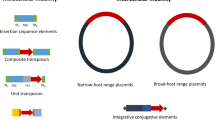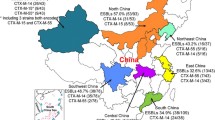Abstract
The detection rates of extended-spectrum β-lactamase (ESBL)-producing bacteria in Japan are very low (∼5%) compared with those obtained worldwide. Further, the current trend of these bacteria in Japan is not known, and few studies with longitudinal observations have been reported. To obtain epidemiologic data on ESBL-producing bacteria, their genotypic features, and their antibiotic resistance patterns in Japan, we analyzed bacterial isolates from hospitalized patients at our institution over the 7-year period from 2003 to 2009. Of 2,304 isolates, 202 (8.8%) were found to be ESBL producers, including Escherichia coli, Klebsiella pneumonia, and Proteus mirabilis. The detection rates of the ESBL-producing isolates gradually increased and reached 17.1% and 10.5% for the E. coli and K. pneumoniae strains, respectively, in 2009. Genotyping analysis showed that ∼90% of the ESBL-producing isolates carried the CTX-M genotype, in which the CTX-M-9 group was predominant, although the CTX-M-2 group is considered to be the main genotype in Japan; further, many of the strains produced multiple β-lactamases. The detection rates of ESBL-producing bacteria may tend to be high within a limited region in Japan. A countrywide survey is required to understand the trend for ESBL-producing bacteria at the national level. In addition, our findings suggest that the genotypes of the detected ESBL producers are similar to those exhibiting a successful nosocomial spread worldwide.
Similar content being viewed by others
References
Cantón R, Coque TM (2006) The CTX-M beta-lactamase pandemic. Curr Opin Microbiol 9(5):466–475
Pitout JD, Laupland KB (2008) Extended-spectrum beta-lactamase-producing Enterobacteriaceae: an emerging public-health concern. Lancet Infect Dis 8(3):159–166
Ramphal R, Ambrose PG (2006) Extended-spectrum beta-lactamases and clinical outcomes: current data. Clin Infect Dis 42(Suppl 4):S164–S172
Ishii Y, Ohno A, Taguchi H, Imajo S, Ishiguro M, Matsuzawa H (1995) Cloning and sequence of the gene encoding a cefotaxime-hydrolyzing class A beta-lactamase isolated from Escherichia coli. Antimicrob Agents Chemother 39(10):2269–2275
Yamaguchi K, Ishii Y, Iwata M, Yoshida H, Satoh T, Watanabe N, Uehara N, Murakami M, Takahashi A, Yasujima M, Kasai T, Itoh K, Shibuya Y, Suwabe A, Obata R, Kanno H, Kubo S, Kaku M, Kanemitsu K, Maesaki S, Hashikita G, Igari J, Oguri T, Aihara M, Kinoshita S, Okada J, Tazawa Y, Taminato T, Negayama K, Nakashima H, Takemura H, Murase M, Miyamoto H, Horii T, Kusano N, Mihara E, Baba H, Ishigo S, Kambe M, Itaha H, Fujita N, Komori T, Ono J, Yoshimura H, Ichiyama S, Maeda S, Hirakata Y, Matsuda J, Yamanaka K, Murata Y, Saikawa T, Hiramatsu K (2004) Nationwide surveillance of parenteral antibiotics containing meropenem activities against clinically isolated strains in 2002. Jpn J Antibiot 57(1):70–104
Yamaguchi K, Murakami M, Takahashi A, Ishii Y, Iwata M, Itoh K, Oohara T, Watanabe N, Uehara N, Nomura F, Watanabe M, Yasujima M, Kasai T, Kanno H, Aihara M, Suwabe A, Yamahata K, Maesaki S, Hashikita G, Kaku M, Kanemitsu K, Miyake K, Oguri T, Yoshida H, Nishiyama K, Okada J, Tazawa Y, Komatsu M, Nakashima H, Takemura H, Kinoshita S, Okada M, Kobayashi S, Taminato T, Negayama K, Horii T, Murase M, Miyamoto H, Baba H, Kusano N, Mihara E, Ishigo S, Kambe M, Itaha H, Fujita N, Komori T, Ono J, Yoshimura H, Ichiyama S, Maeda S, Hirakata Y, Matsuda J, Yamanaka K, Mutara Y, Saikawa T, Hiramatsu K, Taminato S (2005) Nationwide surveillance of parenteral antibiotics containing meropenem activities against clinically isolated strains in 2004. Jpn J Antibiot 58(6):655–689
Yamaguchi K, Ishii Y, Iwata M, Watanabe N, Uehara N, Yasujima M, Kasai T, Suwabe A, Yamahata K, Kaku M, Kanemitsu K, Imafuku Y, Nishiyama K, Murakami M, Yomoda S, Taniguchi N, Yamada T, Nomura F, Watanabe M, Kanno H, Aihara M, Maesaki S, Hashikita G, Kondo S, Misawa S, Horiuchi H, Tazawa Y, Nakashima H, Takemura H, Okada M, Yamazaki F, Horii T, Maekawa M, Baba H, Ishigo S, Fujita N, Komori T, Ichiyama S, Iinuma Y, Maeda S, Yamanaka K, Murata Y, Matsuo S, Kohno H, Kinoshita S, Fujita J, Negayama K, Murase M, Miyamoto H, Kusano N, Mihara E, Itaha H, Ono J, Yoshimura H, Yanagihara K, Matsuda J, Saikawa T, Hiramatsu K (2007) Nationwide surveillance of parenteral antibiotics containing meropenem activities against clinically isolated strains in 2006. Jpn J Antibiot 60(6):344–377
Rossi F, Baquero F, Hsueh PR, Paterson DL, Bochicchio GV, Snyder TA, Satishchandran V, McCarroll K, DiNubile MJ, Chow JW (2006) In vitro susceptibilities of aerobic and facultatively anaerobic Gram-negative bacilli isolated from patients with intra-abdominal infections worldwide: 2004 results from SMART (Study for Monitoring Antimicrobial Resistance Trends). J Antimicrob Chemother 58(1):205–210
Chong Y, Yakushiji H, Ito Y, Kamimura T (2010) Cefepime-resistant Gram-negative bacteremia in febrile neutropenic patients with hematological malignancies. Int J Infect Dis [Epub ahead of print]
National Committee for Clinical Laboratory Standards (NCCLS) (2004) Performance Standards for Antimicrobial Susceptibility Testing. 14th Informational Supplement. NCCLS, Wayne, PA
Muratani T, Kobayashi T, Matsumoto T (2006) Emergence and prevalence of beta-lactamase-producing Klebsiella pneumoniae resistant to cephems in Japan. Int J Antimicrob Agents 27(6):491–499
Romero L, López L, Rodríguez-Baño J, Ramón Hernández J, Martínez-Martínez L, Pascual A (2005) Long-term study of the frequency of Escherichia coli and Klebsiella pneumoniae isolates producing extended-spectrum beta-lactamases. Clin Microbiol Infect 11(8):625–631
Xiong Z, Zhu D, Wang F, Zhang Y, Okamoto R, Inoue M (2002) Investigation of extended-spectrum beta-lactamase in Klebsiellae pneumoniae and Escherichia coli from China. Diagn Microbiol Infect Dis 44(2):195–200
Paterson DL, Hujer KM, Hujer AM, Yeiser B, Bonomo MD, Rice LB, Bonomo RA; International Klebsiella Study Group (2003) Extended-spectrum beta-lactamases in Klebsiella pneumoniae bloodstream isolates from seven countries: dominance and widespread prevalence of SHV- and CTX-M-type beta-lactamases. Antimicrob Agents Chemother 47(11):3554–3560
Hawkey PM (2008) Prevalence and clonality of extended-spectrum beta-lactamases in Asia. Clin Microbiol Infect 14(Suppl 1):159–165
Bonnet R (2004) Growing group of extended-spectrum beta-lactamases: the CTX-M enzymes. Antimicrob Agents Chemother 48(1):1–14
Shibata N, Kurokawa H, Doi Y, Yagi T, Yamane K, Wachino J, Suzuki S, Kimura K, Ishikawa S, Kato H, Ozawa Y, Shibayama K, Kai K, Konda T, Arakawa Y (2006) PCR classification of CTX-M-type beta-lactamase genes identified in clinically isolated gram-negative bacilli in Japan. Antimicrob Agents Chemother 50(2):791–795
Paterson DL, Bonomo RA (2005) Extended-spectrum beta-lactamases: a clinical update. Clin Microbiol Rev 18(4):657–686
Yu WL, Pfaller MA, Winokur PL, Jones RN (2002) Cefepime MIC as a predictor of the extended-spectrum beta-lactamase type in Klebsiella pneumoniae, Taiwan. Emerg Infect Dis 8(5):522–524
Morosini MI, García-Castillo M, Coque TM, Valverde A, Novais A, Loza E, Baquero F, Cantón R (2006) Antibiotic coresistance in extended-spectrum-beta-lactamase-producing Enterobacteriaceae and in vitro activity of tigecycline. Antimicrob Agents Chemother 50(8):2695–2699
Rodríguez-Baño J, Navarro MD, Romero L, Muniain MA, Perea EJ, Pérez-Cano R, Hernández JR, Pascual A (2006) Clinical and molecular epidemiology of extended-spectrum beta-lactamase-producing Escherichia coli as a cause of nosocomial infection or colonization: implications for control. Clin Infect Dis 42(1):37–45
Acknowledgments
The authors thank Dr. T. Muratani for the technical support and also thank the Hibiki Research Group for Clinical Microbiology.
Author information
Authors and Affiliations
Corresponding author
Rights and permissions
About this article
Cite this article
Chong, Y., Yakushiji, H., Ito, Y. et al. Clinical and molecular epidemiology of extended-spectrum β-lactamase-producing Escherichia coli and Klebsiella pneumoniae in a long-term study from Japan. Eur J Clin Microbiol Infect Dis 30, 83–87 (2011). https://doi.org/10.1007/s10096-010-1057-1
Received:
Accepted:
Published:
Issue Date:
DOI: https://doi.org/10.1007/s10096-010-1057-1




